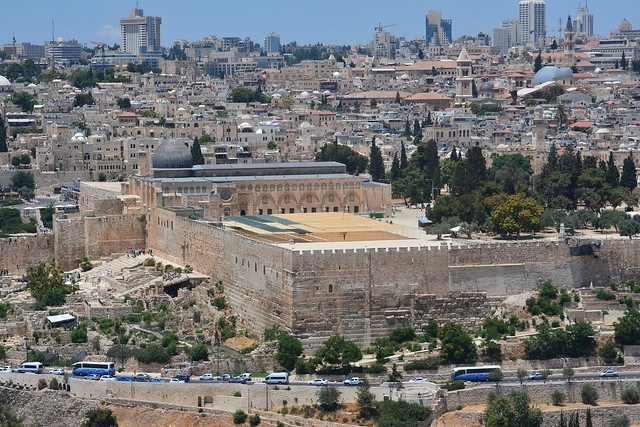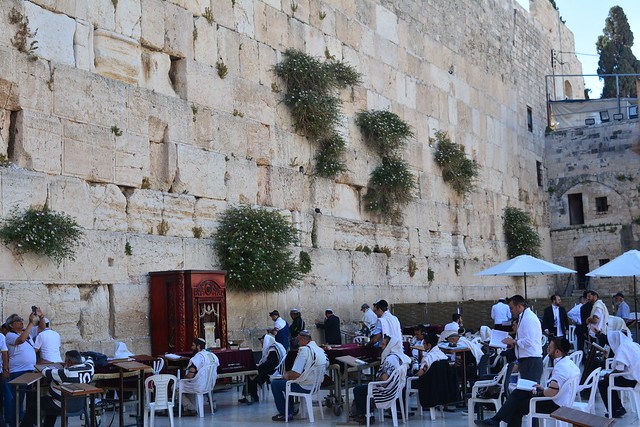
Hebrew is not a commonly taught language in schools around the world—most people view it as an ancient religious language. However, modern Israel has excellent universities and businesses; and is making strides in sustainability, medical technology, finance, and computer science. Israel has produced incredible writers, musicians, and film artists, too. So, what language do they speak in Israel? Consider taking Modern Hebrew courses to build a bond with this exciting country.
Ancient Jewish History
The Old Testament of the Christian Bible overlaps considerably with the Hebrew Bible, and as such, it tells the religious history of Judaism. However, in academic circles, it is debatable how historically accurate the Old Testament is. That said, the Old Testament still includes many historically verifiable details of Jewish history; furthermore, it governs almost every aspect of the Jewish faith to this day.
While many sources casually call the Old Testament the Jewish Bible, it turns out that it is more complicated: Some Jewish texts were part of the written tradition; others were recorded later from ancient oral tradition. Different sects of Judaism subscribe to different texts and/or have different interpretations.
The first 5 books of the Old Testament are known as the Torah (in Hebrew) or the Pentateuch (in Greek). The Masoretes, a group of Middle-Ages Jewish scholars, worked to standardize the Biblical Hebrew translation of the Tanakh (the entirety of Jewish religious teachings). Some of their work is also in Aramaic, a lingua franca (adopted common language to make transactions easier) in the Middle East from the 1st millennium BC to the time of Jesus.
Judaism historically has been a legalistic religion: As such, the Talmud, a text laying out the entirety of Jewish law, has been the go-to text of Judaism. Also, frequently used has been the Midrash, a scholarly interpretation of Hebrew texts, written in a pedagogical tone.
As one might expect, the prophetic books (Jeremiah, Haggai, Isaiah, etc.) of the Old Testament hold more weight in Christianity than they do in Judaism. While technically still Jewish texts, these books are full of predictions of the coming Messiah, whom Christians recognize as Jesus. Also, the Old Testament wisdom books, Psalms and Proverbs, are greatly appreciated in the Western literary tradition.
The Jewish people and other Middle-Easterners actually have a shared heritage: Many are Semitic peoples and use an alphabet of Semitic origin. The main religions of the Middle East (and the world)—Islam, Christianity, and Judaism—are Abrahamic and monotheistic—that is, they recognize Abraham as a founder of their faith and they recognize only one God.

The Jewish people have endured many takeovers—often violent—of their traditional land of habitation (Israel). As a result, the Jews have lived in Diaspora, dispersed throughout the globe, for centuries. Sadly, they have been persecuted frequently, even when full-fledged citizens of the country in which they live: The most infamous example of this is the Holocaust in Nazi-occupied territories of Europe.
The good news is that the Diaspora has allowed peoples all around the globe to benefit from Jewish insights and culture, but it also means that we share many of their problems, too: This is a real incentive to learn more about Semitic ethnicities (Jewish, Arabic, Kurdish, Turkish, etc.).
Recent Israeli/Jewish History
The Jewish Diaspora made its mark on American English: Yiddish words are now part of American slang. Yiddish was developed by Jews living in Central and Eastern Europe, many of whom were driven to the USA by rampant early-1900s anti-Semitism.
The State of Israel is relatively new—created in 1948 from land controlled by Great Britain at the time. This area coincided with ancient kingdom of Israel and included the holy city of Jerusalem. Creating such a state had actually been a century-long goal of the Jewish people, in response to the Jewish enlightenment (Haskalah), and Zionism became the name for the movement to create a Jewish state in the land of Palestine.
Israel’s national flag is a blue and white design that features a Star of David, called the Magen David. The country borders Lebanon, Jordan, Egypt, Syria, and the Mediterranean Sea. Confusingly, it is also bordered by the State of Palestine; however, Palestine is not a recognized country and has been in chronic conflict over certain territories since the modern Israeli State’s beginning. Currently, Israel claims the West Bank (the region on the western bank of the Jordan River), but Palestine disagrees. Similarly, Palestine claims the Gaza Strip (a stretch of land along the Mediterranean Sea), but Israel disagrees.
Tel Aviv has long been the recognized capital of Israel, but in fact, the Israelites view it as analogous to the USA’s New York City—it is a huge economic and technological hub, but not the official capital. Israelites view Jerusalem as their capital; however, so many other countries/groups disagree with their ownership of this holy city, that its status as capital is not internationally recognized.
Originally, modern Israel’s primary economic activity centered on kibbutzim—socialistic agricultural communities. In fact, Israel’s famous early Prime Minister Golda Meir was a kibbutznik. (You might recognize the –nik suffix from such English words as beatnik—meaning “associate of.”) However, the kibbutz has lost prevalence over time to industrial, financial, and technological institutions.
More recently, Israel has an impressive record of entrepreneurship (including among older people and females) and technological innovation, especially in the area of sustainability. Furthermore, it has one of the world’s highest percentages of university-educated citizens.
The Israeli Defense Forces (IDF), however, continue to dominate Israeli society. Most of its citizens are or have been involved in the IDF; in fact, involvement is compulsory for most citizens. The reasons for the IDF’s dominance are complex and involve other countries’ roles in the Middle East.

The State of Judaism Now
Judaism comprises many sects, the largest of which is Rabbinic Judaism. Rabbinic Jews center their teachings on the belief that Moses received both the Torah and the Talmud on Mt. Sinai—in effect, they view the entire Talmud as God-inspired.
Orthodox Judaism can itself be divided further into subgroups, but its essential feature is strict adherence to halakha (the entire body of law described in the Torah). Orthodox Jews believe in a coming Savior, but do not recognize Jesus as such. Conservative Jews similarly believe in strict adherence to halakha, but they believe interpretation of halakha can be changed based on majority opinion.
Reform Judaism is arguably the most liberal sect, as it recognizes the value of change to religious practice and prioritizes morality over tradition. Then, finally, Kabbalah—the term which sometimes is used to refer generally to the esoteric or occult—refers to a mystical approach to biblical interpretation. One could loosely compare it to Sufism in Islam.
Most present-day Jewish holidays are based on longstanding tradition and are celebrated according to mitzvot (plural of mitzvah—the Hebrew word for “commandment”).The mitzvot themselves come from a variety of sources, including rabbinic and scholarly interpretations of the Torah and Jewish historical events. You might recognize this word from the Bar Mitzvah celebration for young Jewish men. (There is also Bat Mitzvah for young women.) Loosely speaking, Pesach, or Passover, is a shared holiday with Christianity, except that Christians emphasize its connection with the Last Supper of Jesus.
What Language Do They Speak in Israel, Today?
Today, Modern Hebrew is the language of the State of Israel. Modern Hebrew was standardized from Biblical Hebrew (also known as Ancient Hebrew); Modern Hebrew and Ancient Hebrew are similar enough that, if you can read one, you probably can read the other. (This is similar to the way a modern English speaker can enjoy the works of Shakespeare but might struggle with some archaic vocabulary.) Scholars observe that Modern Hebrew is stripped down compared to Ancient Hebrew: the modern language has fewer verbs and expressive nuances.
Modern Hebrew normally uses a subject-verb-object sentence order (as does English), in contrast to Ancient Hebrew’s verb-subject-object order. Both are read from right to left and use the same alphabet. The Jewish alphabet contains 22 symbols that represent consonants. Vowels are indicated using diacritics (marks added to a symbol/letter). Both Ancient and Modern Hebrew are highly inflected languages—a word’s role in a sentence is indicated by changes to the word itself, rather than by helping words or word order.
While some Israelis speak English (and other languages) fluently, many can only speak Hebrew. Therefore, if you would like to become a part of this country’s society in any way—getting a job, starting a business, enrolling as a student, etc.—you should work to become somewhat fluent in Modern Hebrew.
The Most Elite Israeli Universities and Their Contributions
The Weizmann Institute of Science was founded in 1934 (over a decade before the creation of the State), by a Jewish-English couple in memory of their son. The Institute was later renamed for Dr. Chaim Weizmann, the first president of the State of Israel. The Institute specializes in scientific studies and research—chemistry, physics, biology, biochemistry, and archaeology. It is located in the city of Rehovot, a few miles south of Tel Aviv.
The Hebrew University of Jerusalem was founded in 1918 (exactly 30 years before the State’s founding) by Albert Einstein, Judah Leon Magnes (a rabbi who advocated the formation of a Jewish-and-Arab state in Palestine), and Dr. Chaim Weizmann (same as above). Its four campuses together offer a wide variety of programs, including schools of medicine, dentistry, environmental studies, education, public policy, law, and much more—including the Israel Institute of Biblical Studies. It also has the world’s largest Jewish studies library.
The largest university in the State, Tel Aviv University was founded in 1956. As you might expect, it offers almost any undergraduate or graduate degree you could imagine and contains multiple extensive research facilities. It contains the Sackler School of Medicine, Israel’s largest medical school.
The Technion – Israel Institute of Technology is in Haifa, Israel. Haifa is the largest port city and 3rd largest overall, after Jerusalem and Tel Aviv; it is known for its dedication to religious tolerance. The Technion is the oldest university in the State, founded in 1912 when the area was under the Ottoman Empire. The school offers degrees and research positions in areas of science, technology, and engineering; and is involved in international collaboration, as well.

The Best and Most Famous Israeli Dishes
No study of modern Israel would be complete without at least a brief discussion of Jewish cuisine: in fact, Jewish cooking is a melting pot of elements from the whole Middle East. The pita, popular in the West, is an Israeli staple. The Israelis frequently use hummus and falafel in their street food; if you are vegetarian or vegan, you will not feel deprived in Israel.
If you worry about missing eggs in the morning, no problem—Shakshouka is a common breakfast or lunch option in Israel. If you are a salad-lover, the Israeli salad is a common veggie side dish for many meals. Adventuresome meat lovers will enjoy a Jerusalem mixed grill.
Notable Israelis in the Arts and Sciences
One of the most famous Israeli vocal artists is Ofra Haza, known as “the Israeli Madonna” (and, in fact, Madonna was a co-writer for one of her songs—“You”). Sadly, this beautiful mezzo-soprano passed away in 2000.
Another very important modern Israeli is Gili Bar-Hillel, who translated the entire text of the Harry Potter series novels into Hebrew. Understandably, this made her a beloved figure among her people, since Israelis love Harry Potter just as much as the rest of us do.
Judea Pearl, the 2011 winner of the Turing Award, is an international name in the fields of artificial intelligence, computer science, and philosophy. He is the father of Wall Street Journal journalist, Daniel Pearl, who was killed by a violent anti-Israeli group in 2002. Judea Pearl’s response to his son’s death, however, has been to advocate peace and unity. Pearl’s foundational work in probabilistic artificial intelligence has been, and likely will continue to be, world-changing.
Why You Might Want to Learn the Language of Israel
If you are a biblical, religious, or anthropological scholar—learning Hebrew, both Modern and Biblical, is worthwhile: You will be able to see the connections between the extensive history and complex current events of this area of the world. Also, if your business or academic work leads you to Israel, learning Modern Hebrew will allow you to communicate more freely and be more understanding of your Israeli peers.
Photos courtesy of Rich Paul on Flickr.